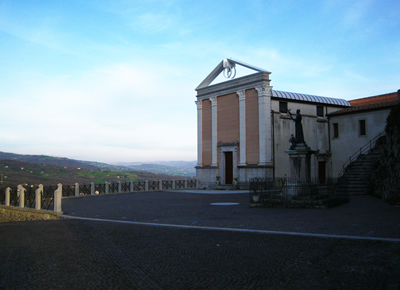 La cattedrale venne edificata intorno al 1009, in onore dell’Assunta. Tra il 1200 e il 1460 subì numerose modifiche e ampliamenti, sia in altezza che in larghezza. I danni più gravi conseguirono al terremoto del 1694 e all’incendio del 1707, che distrussero molti oggetti preziosi. L’interno dell’edificio presenta una pianta a croce latina e una sola imponente navata centrale. Al suo interno erano conservate molte opere di interesse artistico che, in seguito al terremoto del 1980, vennero trasferite in altre sedi, anche fuori del paese. Quest’evento ha segnato una svolta per la struttura dell’edificio, oggi completamente ricostruito e svuotato. Tra i cimeli più importanti, ricordiamo il trono vescovile, opera barocca in legno di noce, oggi conservato nella chiesa di Sant’Andrea Apostolo, nello stesso paese, donato dalla famiglia Orsini, e diverse tele oggi conservate presso il Museo Archeologico di Muro Lucano. Tra gli ecclesiastici che ospitò questa cattedrale, si annoverano Mons. Tommaso Confetti, Mons. Manfredi e Mons. Capone.
La cattedrale venne edificata intorno al 1009, in onore dell’Assunta. Tra il 1200 e il 1460 subì numerose modifiche e ampliamenti, sia in altezza che in larghezza. I danni più gravi conseguirono al terremoto del 1694 e all’incendio del 1707, che distrussero molti oggetti preziosi. L’interno dell’edificio presenta una pianta a croce latina e una sola imponente navata centrale. Al suo interno erano conservate molte opere di interesse artistico che, in seguito al terremoto del 1980, vennero trasferite in altre sedi, anche fuori del paese. Quest’evento ha segnato una svolta per la struttura dell’edificio, oggi completamente ricostruito e svuotato. Tra i cimeli più importanti, ricordiamo il trono vescovile, opera barocca in legno di noce, oggi conservato nella chiesa di Sant’Andrea Apostolo, nello stesso paese, donato dalla famiglia Orsini, e diverse tele oggi conservate presso il Museo Archeologico di Muro Lucano. Tra gli ecclesiastici che ospitò questa cattedrale, si annoverano Mons. Tommaso Confetti, Mons. Manfredi e Mons. Capone.
 The Cathedral was built around 1009, in honour of the “Madonna dell’Assunta”. Between 1200 and 1460 the Cathedral underwent many changes and enlargements in height and width. The earthquake of 1964 and the fire of 1707 caused the worst damages of it and the destruction of many valuable objects. The interior has a latin cross plan and a single imposing central nave. Many artistic works were preserved on the inside, but they were moved to several other locations, out of the town too, after the earthquake of 1980. After this event, the Cathedral had to be completely rebuilt. The most important relics include the Bishop’s Throne, a Baroque work in walnut, now preserved in the Church of “Sant’Andrea Apostolo” in Muro Lucano. Many paintings are now kept at the Archeological Museum in Muro Lucano. The members of the clergy that this Cathedral hosted include Monsignor Capone, Monsignor Confetti and Monsignor Manfredi.
The Cathedral was built around 1009, in honour of the “Madonna dell’Assunta”. Between 1200 and 1460 the Cathedral underwent many changes and enlargements in height and width. The earthquake of 1964 and the fire of 1707 caused the worst damages of it and the destruction of many valuable objects. The interior has a latin cross plan and a single imposing central nave. Many artistic works were preserved on the inside, but they were moved to several other locations, out of the town too, after the earthquake of 1980. After this event, the Cathedral had to be completely rebuilt. The most important relics include the Bishop’s Throne, a Baroque work in walnut, now preserved in the Church of “Sant’Andrea Apostolo” in Muro Lucano. Many paintings are now kept at the Archeological Museum in Muro Lucano. The members of the clergy that this Cathedral hosted include Monsignor Capone, Monsignor Confetti and Monsignor Manfredi.
